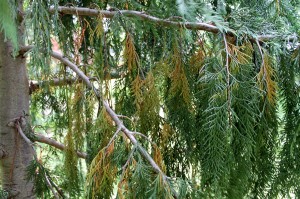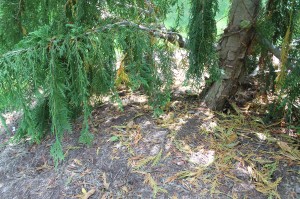What Now Brown Evergreen?
June 24th, 2014
A few weeks ago, tons of gardeners were fretting about whether their butterfly bushes, crape myrtles, hydrangeas and such would bounce back from their winter de-leafing and diebacks.

Browning of evergreens like on this weeping Alaska cedar is more pronounced this year… but usually not a sign of impending doom.
For the most part, they have.
It took forever because of the cool start to the season, but by and large, winter-damaged plants have either re-leafed or pushed new growth from the base to replace dead shoots.
What’s more on people’s minds now is the sad state of some needled evergreens.
Like broadleaf evergreens such as holly, boxwood and cherry laurel, needled evergreens (spruce, fir, pine, etc.) continue to lose moisture all winter. When the ground freezes for a long period of time, plants can’t replace the lost moisture. At some point, the “account gets overdrawn,” and the needles brown, starting with the tips first.
Leyland cypress is at the top of this year’s browning list.
This super-fast-growing screening evergreen took variable hits, ranging from ones that totally browned all over to ones that browned only the wind side to ones that came out of winter looking fairly normal.
Cryptomeria (Japanese red cedar) is another species that’s had browning issues. And surprisingly, even many comfortably cold-hardy weeping Alaska cedars are looking haggard.
The question everyone wants answered is whether these browned and brownish evergreens are going to be OK.
Like most issues in gardening, the answer is, “It depends.”
The deciding matter is whether the beating was enough to outright kill the branches and roots or just enough that it stressed the plants into more needle browning than normal.
Each species’ genetic cold tolerance is one factor. That explains why Leyland cypress took more of a hit than, say, arborvitae or juniper. Leyland cypress is rated for Zone 6 winters, which means -5 to -10 degrees is all it can tolerate.
Age of the plant is another factor. Evergreens just planted last summer or fall fared worse than established ones because the roots hadn’t had a chance to develop.
The specific site is another factor. Plants in open, windy sites or along roads where they got hit with salty snow-throw generally fared worse than ones in more wind-protected sites.
I can’t figure out why established weeping Alaska cedars are looking tattered, so chalk that one up as a mystery.
At any rate, a key clue to recovery is whether the needle browning is the whole way out to the ends of the branches or just the older, inner needles.
If the browning is confined to the needles toward the inside of the branches, those will drop, and the tree will be fine.
That’s what I’m seeing with Alaska cedar and cryptomeria. These just look bad now because there’s been more winter browning than usual and because those are species that don’t drop brown needles as fast as some species (i.e. white pine, which drops them all in fall within a couple of weeks).
So long as the outer growth (needles toward the end of branches) is green, your evergreens will recover. As this year’s growth occurs and the brown needles drop, things will look better and better as the season progresses.
On the other hand, if you’re seeing needles that are brown the whole way to the ends of the branches with no sign of new growth emerging, that’s a bad sign. Those branches are likely dead. You should be seeing new growth by now.
If browning is the case all over, the whole tree is dead.
I’ve seen Leyland cypresses in all camps. Ones that had some mild browning are pushing new growth and starting to come around. Others are totally brown and showing no sign of life.
A tougher call is ones in the middle – very brown but trying to push new growth from the interior.
With these, all you can do is trim off the dead wood and hope that there’s enough live growth for the tree to fill back in.
That’s going to require some patience, so the deciding factor could be how long you’re willing to put up with a scraggly and/or mostly bare screening plant that really isn’t screening anything at the moment.
Two other tests to determine whether your trees are dead or alive…
* The bend test. Try bending a needleless branch and see if it gives or snaps. Dead wood will snap fairly easily under pressure instead of bending.
* The scratch test. Use a blade to peel a little bark off a needleless branch and look at the color of the wood underneath. Live wood will be green; dead wood will be brown.
Keep in mind that you might be evaluating a tree that’s still in the process of dying.
Needled evergreens are pretty good at holding some needle and branch moisture for weeks after they’ve passed the point of no return. Think about how a Christmas tree stays green for more than a month inside even after it’s been totally separated from its roots.
A branch may bend for now or be green underneath and still be dead. All of the watering and fertilizing you can muster won’t make a bit of difference in that event.








